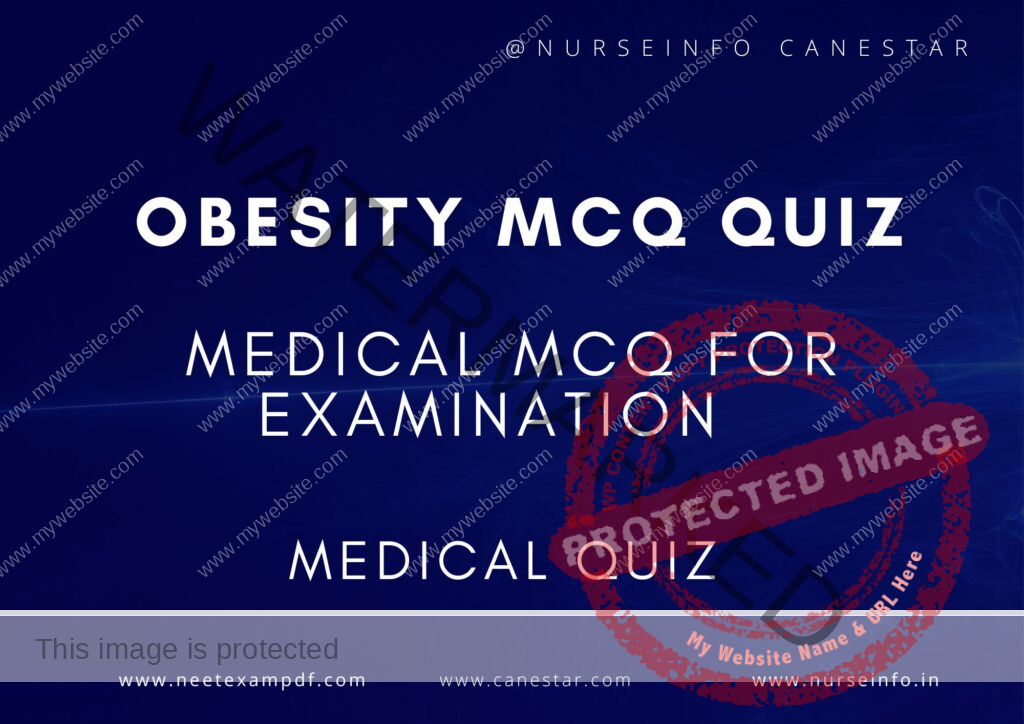MULTIPLE CHOICE QUESTIONS ON OBESITY QUIZ – MCQS WITH RATIONALE ANSWER – OBESITY MCQ QUESTIONS WITH RATIONALE
MCQ FOR OBESITY QUIZ
These mcqs are prepared exclusively for medical professionals for exam preparation. MCQ is helpful to remember the concept onobesity mcq quiz. This multiple choice questions are helpful for preparation for DHA, PROMETRIC, MOH, HAAD, NCLEX, Medical, NEET and Nursing EXAMINATION
OBESITY MCQ QUIZ
Obesity MCQs with Rationale Answers
Which of the following is considered the most accurate method for assessing body fat composition?
a) BMI (Body Mass Index)
b) Waist circumference
c) Bioelectrical impedance analysis
d) Dual-energy X-ray absorptiometry (DEXA)
Answer: d) Dual-energy X-ray absorptiometry (DEXA)
Rationale: DEXA is considered the gold standard for measuring body composition, including fat mass and lean body mass, due to its accuracy and reliability.
Which hormone is primarily responsible for regulating appetite and is often found at lower levels in individuals with obesity?
a) Insulin
b) Leptin
c) Ghrelin
d) Cortisol
Answer: b) Leptin
Rationale: Leptin is produced by fat cells and helps regulate energy balance by inhibiting hunger. Lower levels of leptin or leptin resistance can contribute to increased appetite and obesity.
What is the primary role of ghrelin in the body?
a) Suppress appetite
b) Stimulate appetite
c) Increase metabolism
d) Decrease fat storage
Answer: b) Stimulate appetite
Rationale: Ghrelin is known as the “hunger hormone” because it stimulates appetite, increases food intake, and promotes fat storage.
Which of the following is NOT a risk factor for obesity?
a) Physical inactivity
b) High-fat diet
c) Genetics
d) High protein diet
Answer: d) High protein diet
Rationale: While physical inactivity, high-fat diets, and genetics are established risk factors for obesity, a high-protein diet, when balanced and controlled, is generally associated with weight management rather than obesity.
Which medication is commonly prescribed to aid weight loss by inhibiting fat absorption in the intestines?
a) Metformin
b) Phentermine
c) Orlistat
d) Liraglutide
Answer: c) Orlistat
Rationale: Orlistat works by inhibiting pancreatic lipase, an enzyme that breaks down triglycerides in the intestine, reducing fat absorption.
Which bariatric surgery involves creating a small pouch at the top of the stomach and connecting it directly to the small intestine?
a) Gastric banding
b) Sleeve gastrectomy
c) Roux-en-Y gastric bypass
d) Biliopancreatic diversion
Answer: c) Roux-en-Y gastric bypass
Rationale: Roux-en-Y gastric bypass involves creating a small stomach pouch and bypassing a portion of the small intestine, which reduces food intake and nutrient absorption.
Which of the following is a common comorbidity associated with obesity?
a) Hypotension
b) Type 2 diabetes
c) Anemia
d) Osteoporosis
Answer: b) Type 2 diabetes
Rationale: Obesity is a significant risk factor for developing type 2 diabetes due to insulin resistance and metabolic dysregulation.
What is the main function of adiponectin, a hormone secreted by adipose tissue?
a) Increase insulin sensitivity
b) Decrease insulin sensitivity
c) Promote inflammation
d) Increase appetite
Answer: a) Increase insulin sensitivity
Rationale: Adiponectin helps regulate glucose levels and fatty acid breakdown. Higher levels are associated with increased insulin sensitivity and anti-inflammatory effects.
Which type of fat distribution is considered more harmful and is associated with a higher risk of cardiovascular disease?
a) Subcutaneous fat
b) Visceral fat
c) Intramuscular fat
d) Peripheral fat
Answer: b) Visceral fat
Rationale: Visceral fat, stored around the organs in the abdomen, is linked to higher risks of cardiovascular disease, type 2 diabetes, and metabolic syndrome compared to subcutaneous fat.
What is the primary effect of GLP-1 receptor agonists used in obesity treatment?
a) Increase appetite
b) Decrease appetite
c) Slow down metabolism
d) Increase fat absorption
Answer: b) Decrease appetite
Rationale: GLP-1 receptor agonists mimic the effects of the incretin hormone GLP-1, which promotes satiety and reduces appetite, aiding in weight loss.
Which of the following is a major contributing factor to childhood obesity?
a) High physical activity
b) Balanced diet
c) Sedentary lifestyle
d) Genetic disorders
Answer: c) Sedentary lifestyle
Rationale: A sedentary lifestyle, including prolonged screen time and lack of physical activity, is a significant contributing factor to childhood obesity.
Which inflammatory marker is often elevated in individuals with obesity and is linked to increased cardiovascular risk?
a) C-reactive protein (CRP)
b) Hemoglobin A1c
c) Albumin
d) Bilirubin
Answer: a) C-reactive protein (CRP)
Rationale: CRP is an inflammatory marker that is often elevated in obesity and is associated with an increased risk of cardiovascular disease and other obesity-related conditions.
Which dietary approach is commonly recommended for sustainable weight loss and management?
a) High-fat, low-carb diet
b) Balanced diet with portion control
c) High-sugar diet
d) No-carb diet
Answer: b) Balanced diet with portion control
Rationale: A balanced diet with portion control, including a variety of nutrients and appropriate calorie intake, is recommended for sustainable weight loss and management.
Which of the following is a psychological factor that can contribute to obesity?
a) High metabolism
b) Emotional eating
c) Frequent physical exercise
d) Adequate sleep
Answer: b) Emotional eating
Rationale: Emotional eating, or eating in response to stress, boredom, or other emotions, can contribute to excess calorie intake and obesity.
Which exercise recommendation is generally advised for adults to help manage weight and improve health?
a) 30 minutes of moderate exercise daily
b) 10 minutes of vigorous exercise weekly
c) No exercise required
d) Only strength training
Answer: a) 30 minutes of moderate exercise daily
Rationale: Engaging in at least 30 minutes of moderate-intensity exercise most days of the week is recommended to help manage weight and improve overall health.
Which of the following is a common metabolic syndrome component associated with obesity?
a) Hypotension
b) Hyperglycemia
c) Low triglycerides
d) Bradycardia
Answer: b) Hyperglycemia
Rationale: Metabolic syndrome includes a cluster of conditions such as hyperglycemia, hypertension, elevated triglycerides, low HDL cholesterol, and abdominal obesity.
Which type of diet has been shown to be effective in reducing visceral fat in individuals with obesity?
a) Low-fat diet
b) Low-carb, high-protein diet
c) High-sugar diet
d) No-protein diet
Answer: b) Low-carb, high-protein diet
Rationale: A low-carb, high-protein diet has been shown to reduce visceral fat, improve metabolic health, and aid in weight loss.
Which behavioral therapy technique is often used to help individuals with obesity change their eating habits?
a) Hypnosis
b) Cognitive-behavioral therapy (CBT)
c) Electroconvulsive therapy
d) Psychoanalysis
Answer: b) Cognitive-behavioral therapy (CBT)
Rationale: CBT is an effective therapy technique for helping individuals change unhealthy eating habits and develop strategies for managing weight.
What is the role of the hypothalamus in obesity?
a) It increases muscle mass
b) It regulates hunger and energy expenditure
c) It produces digestive enzymes
d) It stores fat
Answer: b) It regulates hunger and energy expenditure
Rationale: The hypothalamus plays a crucial role in regulating hunger, satiety, and energy expenditure, which are key factors in the development and management of obesity.
Which dietary component is most important to monitor to prevent weight gain and manage obesity?
a) Fiber intake
b) Caloric intake
c) Vitamin intake
d) Protein intake
Answer: b) Caloric intake
Rationale: Monitoring and managing caloric intake is essential to prevent weight gain and manage obesity, as excessive calorie consumption leads to fat accumulation.


